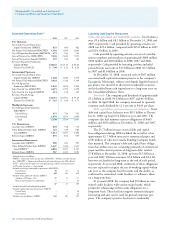Chevron 2008 Annual Report Download - page 37
Download and view the complete annual report
Please find page 37 of the 2008 Chevron annual report below. You can navigate through the pages in the report by either clicking on the pages listed below, or by using the keyword search tool below to find specific information within the annual report.
Chevron Corporation 2008 Annual Report 35
The company has been closely monitoring the ongoing
uncertainty in financial and credit markets, the rapid decline
in crude-oil prices that began in the second half of 2008,
and the general contraction of worldwide economic activity.
Management is taking these developments into account in
the conduct of daily operations and for business planning.
The company remains confident of its underlying financial
strength to deal with potential problems presented in this
environment.
Comments related to earnings trends for the company’s
major business areas are as follows:
Upstream Earnings for the upstream segment are closely
aligned with industry price levels for crude oil and natural
gas. Crude-oil and natural-gas prices are subject to external
factors over which the company has no control, including
product demand connected with global economic conditions,
industry inventory levels, production quotas imposed by the
Organization of Petroleum Exporting Countries (OPEC),
weather-related damage and disruptions, competing fuel
prices, and regional supply interruptions or fears thereof that
may be caused by military conflicts, civil unrest or political
uncertainty. Moreover, any of these factors could also inhibit
the company’s production capacity in an affected region.
The company monitors developments closely in the countries
in which it operates and holds investments, and attempts to
manage risks in operating its facilities and business.
Price levels for capital and exploratory costs and operat-
ing expenses associated with the efficient production of crude
oil and natural gas can also be subject to external factors
beyond the company’s control. External factors include not
only the general level of inflation but also prices charged by
the industry’s material- and service-providers, which can be
affected by the volatility of the industry’s own supply and
demand conditions for such materials and services. Capital
and exploratory expenditures and operating expenses also
can be affected by damages to production facilities caused by
severe weather or civil unrest.
Industry price levels for crude oil were volatile during
2008. The spot price for West Texas Intermediate (WTI)
crude oil, a benchmark crude, started 2008 at $96 per barrel
and peaked at $147 in early July. At the end of the year, the
WTI price had fallen to $45 per barrel. As of mid-February
2009, the WTI price was $38 per barrel. The collapse in
price during the second half of 2008 was largely driven by a
decline in the demand for crude oil that was associated with
a significant weakening in world economies. The WTI price
averaged $100 per barrel for the full-year 2008, compared
with $72 in 2007.
As in 2007, a wide differential in prices existed in 2008
between high-quality (i.e., high-gravity, low-sulfur) crude
oils and those of lower quality (i.e., low-gravity, high-sulfur
crude). The relatively lower price for the high-sulfur crudes
has been associated with an ample supply and relatively lower
demand due to the limited number of refineries that are able
to process this lower-quality feedstock into light products
(i.e., motor gasoline, jet fuel, aviation gasoline and diesel
fuel). Chevron produces or shares in the production of heavy
crude oil in California, Chad, Indonesia, the Partitioned
Neutral Zone between Saudi Arabia and Kuwait, Venezuela
and certain fields in Angola, China and the United Kingdom
North Sea. (Refer to page 42 for the company’s average
U.S. and international crude oil realizations.)
In contrast to price movements in the global market
for crude oil, price changes for natural gas in many regional
markets are more closely aligned with supply-and-demand
conditions in those markets. In the United States during
2008, benchmark prices at Henry Hub averaged about $9
per thousand cubic feet (MCF), compared with about $7 in
2007. At December 31, 2008, and as of mid-February 2009,
WTI Crude Oil and Henry Hub Natural Gas Spot Prices —
Quarterly Average
0
60
150
120
90
30
0
10
25
20
15
5
#009 – rude Oi Prices 2006 th ough 2008 – 3
1Q 2Q 3Q 4Q 1Q 1Q2Q 2Q3Q 3Q4Q 4Q
$/mcf$/bbl
2006 2007 2008
WTI
HH
0
2000
1500
500
1000
0.00
8.00
6.00
4.00
2.00
U.S. Natural Gas Realizations
& Net Production
Prices in Dollars per Thousand
Cubic Feet (right scale)
Production in Millions of
Cubic Feet per Day (left scale)
Average prices increased 29 percent
during 2008. Production was lower
due to natural field declines and
the impact of hurricanes in the
Gulf of Mexico.
0504 06 07 08
$7.90
1,501
0
2000
1500
1000
500
Net Crude Oil & Natural Gas
Liquids Production*
Thousands of barrels per day
United States
International
Net liquids production declined
6 percent in 2008 due mainly to the
impact of higher prices on volumes
recovered under certain production-
sharing and variable-royalty
agreements outside the United
States and damage to production
facilities caused by hurricanes in the
U.S. Gulf of Mexico.
* Includes equity in affiliates, but
excludes other produced volumes.
0504 06 07 08
1,649
























